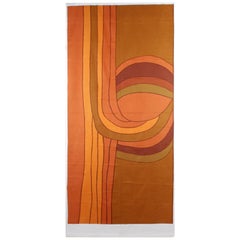Gretl And Wollner
Recent Sales
Vintage 1970s American Modern Decorative Art
Fabric
Knoll for sale on 1stDibs
As a company that produced many of the most famous and iconic furniture designs of the 20th century, Knoll was a chief influence in the rise of modern design in the United States. Led by Florence Knoll, the firm would draw stellar talents such as Ludwig Mies van der Rohe and Eero Saarinen into its compass. Their work would help change the face of the American home and office.
The company was formed in 1938 by the German immigrant Hans Knoll. He first worked with his fellow ex-pat, the Danish designer Jens Risom, who created furniture with flowing lines made of wood. While Risom served in World War II, in 1943 Knoll met his future wife, Florence Schust. She had studied and worked with eminent emigré leaders of the Bauhaus, including Mies, Walter Gropius and Marcel Breuer. She won Knoll over with Bauhaus notions of industrial arts, and an aesthetic that featured flat and tubular metal frames and angular forms. When Hans died in a car crash in 1955, Florence Knoll was appointed head of the company. It was as much through her holistic approach to design — a core division of the firm was dedicated to planning office systems — as Knoll's mid-century modern furnishings themselves that she brought about the sleek and efficient transformation of the American workplace.
Today, classic Knoll furnishings remain staples of modern design collections and decor. A history of modern design is written in pieces such as the elegant Barcelona chair — created by Mies and Lilly Reich — Saarinen’s pedestal Tulip chair, Breuer’s tubular steel Wassily lounge chair and the grid-patterned Diamond chair by Harry Bertoia.
As you can see from the collection of these designs and other vintage Knoll dining chairs, sofas and tables on 1stDibs, this manufacturer's offerings have become timeless emblems of the progressive spirit and sleek sophistication of the best of modernism.
A Close Look at modern Furniture
The late 19th and early 20th centuries saw sweeping social change and major scientific advances — both of which contributed to a new aesthetic: modernism. Rejecting the rigidity of Victorian artistic conventions, modernists sought a new means of expression. References to the natural world and ornate classical embellishments gave way to the sleek simplicity of the Machine Age. Architect Philip Johnson characterized the hallmarks of modernism as “machine-like simplicity, smoothness or surface [and] avoidance of ornament.”
Early practitioners of modernist design include the De Stijl (“The Style”) group, founded in the Netherlands in 1917, and the Bauhaus School, founded two years later in Germany.
Followers of both groups produced sleek, spare designs — many of which became icons of daily life in the 20th century. The modernists rejected both natural and historical references and relied primarily on industrial materials such as metal, glass, plywood, and, later, plastics. While Bauhaus principals Marcel Breuer and Ludwig Mies van der Rohe created furniture from mass-produced, chrome-plated steel, American visionaries like Charles and Ray Eames worked in materials as novel as molded plywood and fiberglass. Today, Breuer’s Wassily chair, Mies van der Rohe’s Barcelona chair — crafted with his romantic partner, designer Lilly Reich — and the Eames lounge chair are emblems of progressive design and vintage originals are prized cornerstones of collections.
It’s difficult to overstate the influence that modernism continues to wield over designers and architects — and equally difficult to overstate how revolutionary it was when it first appeared a century ago. But because modernist furniture designs are so simple, they can blend in seamlessly with just about any type of décor. Don’t overlook them.
Finding the Right decorative-art for You
Antique, new and vintage decorative art is crucial to personalizing your interior.
Bringing art into your home will help you create a warm and welcoming atmosphere, whether you are expecting to regularly host guests for cocktails in your living room or you are inclined to soak up some “me time” on weekends by curling up with a book in your library. After all, a room isn’t quite complete until you hang some art on the walls.
Choosing a piece of art for your interior is a matter of finding something that resonates with you. You should also consider what will work with your current decor. Keep in mind that a wide range of objects counts as decorative art — antique and vintage prints, paintings, wall-mounted sculptures and more. There is so much to choose from! And art can feel as deeply personal with the vintage posters that promoted your favorite classic films as it can with framed photographs of your loved ones.
Decorative art can set the mood for a room and will typically make for great conversation. When you find wall decor and decorations that speak to you, why not introduce them into your space? It will give you and your guests the opportunity to meaningfully engage with the art every time you see it. You can play with different styles, eras and colors. Mix and match pieces to integrate a refreshing pop of color or create a theme by dedicating a room to a color palette or certain time period. A great way to tie your layout together is to choose wall art that complements your decor and color scheme.
Folk art is an interesting category for its wide range of works across various media and the array of textures it can offer. Paper art is another versatile option because it will be easy to find a home for portraits, collages, drawings and other works in your space. With decorative paper art, you can also get creative with how you arrange your wall art. There are plenty of options that include hanging the works salon-style.
On 1stDibs, find a constantly growing collection of antique and vintage decorative art today.
